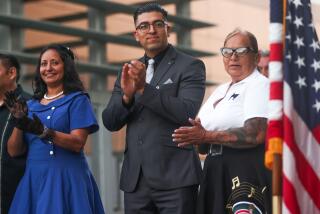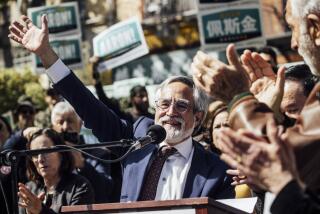PERSPECTIVES ON THE MAYORâS RACE : Our Cities Need More than Money : On the eve of the L.A. election, the mayor of another embattled city offers an optimistic view of the urban landscape.
The nationâs major cities band together on a continuous and unwavering basis to promote our common interests. We share problems of homelessness, disproportionate crime, racial segregation and poor educational opportunities. We fight together for federal funds, mindful that state and local resources are insufficient to deal with the proverbial âhuddled massesâ who inhabit great portions of our cities, now bereft of wealthier neighbors who have chosen the suburbs.
That condition is our common denominator, and it overshadows differences of ideology and partisanship. The urban need is so great that Republicans and Democrats, liberals and conservatives, flock to Washington to argue for more federal help. One glorious time we even agreed that the single most important priority--for all of our cities--was to provide subsidized child care for all needy children. It was our hope that through proper nutrition and preschool education, our poor kids would be able to compete on a fair basis at least up until they were 6.
But that solidarity, and that fundamental similarity in our plight is hardly the whole story. In fact, the future of many cities, ranging from Seattle in the Northwest to Miami in the Southeast, is quite bright, as the problems of poverty and race relations begin to be tackled effectively and as the inner city once again becomes attractive to the middle class, the young and even the wealthy.
The renaissance of many American cities can probably be tied to the societal decision to build inner-city attractions and expand the principal workplace, which typically is downtown.
In Miami, Chicago, San Francisco, San Antonio and Baltimore, a key factor is the use of the waterfront. The river, lake or ocean that engendered the initial congregation of people is now recognized as a natural venue for development, entertainment and living.
When people couldnât reach core areas by car, we built rail systems. When the pollution from automobiles began to ruin urban life, we made auto use more expensive, creating an incentive for people to live closer to downtown.
Miami saw all these favorable things, to which was added a remarkable new feature: the attractiveness of our multicultural environment. The immigrant condition, which generates the ethnic diversity that has been viewed as a liability, is now clearly an asset in Miami. South Americans, Europeans, Asians, blacks, whites and Creole Caribbeans have found in Miami a trading mecca, a place to visit, shop, study and engage in technological transfer at all levels.
But even for Miami, questions remain: Can affluence (both native and foreign-based) coexist with endemic poverty long enough to lift the total community to a decent standard of living? Can the races and ethnic groups get along long enough to make viable our fragile balance of urban elements?
The answer, in part, is resources. Money is needed to improve our physical plant, be it traditional (parks, bridges, highways) or non-traditional (sports facilities, attractions, economic development ventures). Since the federal government absorbs $6,000 in taxes from each man, woman and child in America and the cities only a fraction of that amount ($650 in Miami), the burden is on Washington much more than on municipalities.
But the answer is also a question of values. Government can only do so much. It cannot reconstruct the fabric of the family, cannot by itself teach discipline and mutual respect, let alone love for those with whom we live.
In the final analysis, the renaissance of the cities will depend on the revitalization of the churches and the commitment not to abandon us for the quieter, more ethnically homogeneous and less challenging life of the suburbs.
More to Read
Sign up for Essential California
The most important California stories and recommendations in your inbox every morning.
You may occasionally receive promotional content from the Los Angeles Times.










